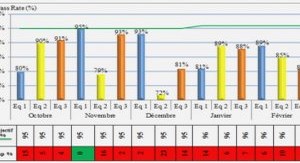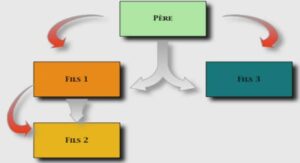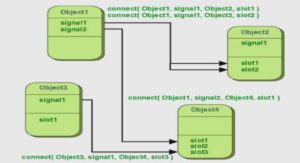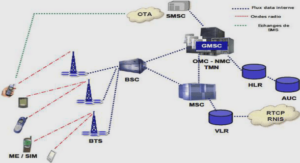Dissolved nutrient (N, P, Si) and particulate matter transfer from the Seybouse and Mafragh estuaries
Particulate materials level and delivery
However, increased NH4 and PO4 supply during the dry season has induced large organic matter production, which increased by 3-fold for SR water and 2-fold for MR waters compared to the wet season. Moreover, Chl a levels was more much elevated than those of the other Mediterranean Rivers (Table 10). This levels displayed high values during the dry period. Similar seasonal levels and patterns of Chl a variability have been reported in many Mediterranean river’ outlets (among others, Ebro River: Sabater et al., 2008; Pô River: Berto et al., 2010; Guadiana River: Domingues et al., 2011; Moulouya River: Tovar-Sánchez et al., 2016). If we assume all the BSi amount is due to diatoms growth and non-living frustules, it may represent only 8-10% of Chl a biomass, depending on the river. This low BSi fraction (or diatom content) may imply that large non-siliceous phytoplankton taxa dominated the river’ waters. However, BSi concentrations from MR and SR are 1.5-fold the mean (28 µmol L-1) of rivers worldwide (Conley, 1997). Both the dominance of nonsiliceous phytoplankton communities and the unbalanced dissolved nutrient availability are signs of eutrophication problems of both river’ waters prevailing throughout the seasons. This also results in a very elevated amount of particulate organic carbon (POC), which represented, for example, 3 to 6-fold the mean concentration in the rivers discharging in the North Mediterranean Sea (Table 11). Dissolved and particulate material levels and fluxes at the rivers’ outlets Chlorophyll a concentrations (µg L-1) in some selected Mediterranean rivers. Rivers Chl a (µg L-1) Source Rhone, France 2.2 Moutin et al., 1998 Pô, Italy 2-2.6 Berto et al., 2010 Ebro, Spain 5.1 Colella et al., 2016 Nile, Egypt 6.1 Colella et al., 2016 Rhone, France 3.2 Colella et al., 2016 Evros, Greece 5.2 Colella et al., 2016 Axios, Greece 7 Colella et al., 2016 Asi, Turkey 0.3 Colella et al., 2016 Moulouya, Morocco 4 Tovar-Sánchez et al., 2016 Moulouya, Morocco 4.4 Tovar-Sánchez et al., 2016 Moulouya, Morocco 2 Tovar-Sánchez et al., 2016 Mafragh, Algeria 11.62 This study Seybouse, Algeria 20.55 This study Despite the high nutrient input during the dry period, the rivers flow lowering (even leading to clogging the catchment’ outlets of SR and MR) induced a great organic matter stock, which dominated the SPM components (32-45%: 10 mg L-1 of POC). This atypical hydrological functioning (Khélifi-Touhami et al., 2006; Ounissi et al., 2014) favoured such endogenous POC production. However, concentration of the particulate organic nitrogen (PON) was still rather low (0.06-0.13 mg L-1) compared to other Mediterranean rivers (Table 11). Unlike the dissolved inorganic nutrients, fluxes of organic and particulate matter displayed high values, particularly the POC, POP, Chl a and BSi derived from MR catchment. The POC yield reached 875 kg km-2 yr-1 for MR deliveries and formed 5.4% of the SPM amounts. The SR deliveries contributed only a third to the POC. These topsoil losses remain very low compared to the most mediterranean catchements (e.g. Higueras et al., 2014). Similarly, the BSi yield of MR dominated the deliveries into the Annaba Bay, and represented 31% of TSi, but only represented 14% of the POC inputs. Also the PON:POC ratio was very low, indicating the rapid recycling processes of N over C in both catchments. Within total silicon TSi (Si(OH)4 + BSi), BSi contributed with 29.7 and 32% in SR and MR waters, respectively. The contribution of BSi carried by rivers to the world ocean has been recognized (Conley et al., 1997; Garnier et al., 2002), and as potential bioavailable stock (after dissolution) should be considered in silicon budget and cycling (Krom et al., 2004). For example, when compared to Si:N ratio, the TSi:TN ratio increased to 0.9 and 1.70 at SR and MR outlets, respectively, as their respective BSi:PON CHAPTER III Dissolved and particulate material levels and fluxes at the rivers’ outlets 56 AMIRA, A.B., 2018 ratio reached 4.3-8.4. The BSi form is often neglected in biogeochemical studies (Billen and Garnier, 2007), although it can represent 20% of the dissolved silica (Garnier et al., 2002). The comparison of particulate matter fluxes is being difficult as data on Mediterranean rivers are sparse and sadly lacking
ATMOSPHERIC WET DEPOSITION OF NUTRIENTS
Precipitation data Precipitation monitoring data from the Annaba meteorological station over the period 1970-2015 show annual totals in the range 409.5-1126.6 mm yr-1, with averages of 654.50 ±151.17 mm yr-1 (Fig. 26a) and marked seasonal cycles with dry summers (Fig. 26b) typical of the Mediterranean season. Figure 26. Precipitation at Annaba (lower Seybouse and Mafragh catchments); (a): annual precipitation over the period 1970-2015; the red lines indicate the mean ± the standard deviation; (b): monthly average precipitation and standard deviation at Annaba over the period 1970-2015. Given a total rainfall of 595.5 mm, 2014 was slightly drier than the mean and included 16, 12, 21, 4, 8, 3, 1, 0, 5, 9, 5, and 16 rainy days in every month, respectively, from January to December (Fig. 27). The seasonal cycle in 2014 somewhat differed from the Precipitation (mm) (a) Yearly precipitation (mm) Monthly precipitation (geom. mean and std. dev., mm) typical one because the total precipitation over several months was outside their respective average monthly means ±. Two strong precipitation maxima in March and December 2014 compensated for the fact that all other months were significantly drier than usual. As many as 22 rainy days in 2014 had precipitation <1 mm, and 61 experienced more than 2 mm of precipitation, among which 7 days experienced 20 mm or more (46 mm on 7 Dec., 38.2 mm on 7 Nov., 27.4 mm on 4 Oct., 25.1 mm on 5 Mar., 23.1 mm on 28 Jan., 20.1 mm on 5 Oct., and 20.0 mm on 10 Dec.) and nine other days ranged between 10 and 20 mm (Fig. 27). The 16 days with the largest precipitation amounted to more than half of the total annual precipitation (54.5%). Figure 27. Monthly precipitation (mm) over Annaba region (lower Seybouse and Mafragh catchments) during 2014 with total and analyzed rain events; the numbers indicate the number of days. 2. Nutrient levels and fluxes in rainwater The year 2014 was relatively dry, and the precipitation was less than 600 mm. The rainfall amounts of 36% of the 100 rainy days in 2014 were ˂2 mm (Fig. 28). The rainiest months were December (170.5 mm) and March (153 mm), which together provided more than half the precipitation yield in that year. The dissolved nutrient seasonal variations are shown in Figure 28. Overall, the precipitation over Annaba Bay was highly charged with SiO4 and PO4 (Fig. 28), which respectively amounted to 16.70 and 1.54 µmol L-1. However, the concentrations of nitrogen compounds displayed low values; the TDN average value did not exceed 40.5 µmol L-1, of which NO3, NH4 and DON represented 45%, 28.4% and 20%, respectively. The DIN concentration increased by 10% during the dry period, but PO4 and SiO4 displayed high levels, increasing by 64% and 21%, respectively, over the values in the wet period (Fig. 28). Apart from PO4, all nutrients had maximum concentrations during summer, in particular NO3 (28 µmol L-1), DON (17.3 µmol L-1), SiO4 (22.9 µmol L-1) and NH4 (21.9 µmol L-1). In addition, with the exception of NH4 and NO2, all the nutrients dropped to their lowest values during winter (Fig. 28). Moreover, low rainfall days were generally heavily charged with dissolved nutrients in comparison to high rainfall days. However, several rainwater samples from spring and autumn had elevated amounts of SiO4 and PO4 (Fig. 28). The average N:P ratio (30) was not much different from that of the riverine waters, but only 37% of the samples were situated within the range 8>N:P<30. The remaining samples with 8˂N:P˃30 can be considered to be similar to the standard Redfield ratio. The average value of Si:N (0.66) was found to be remarkably comparable to that of the SR waters. Moreover, almost all samples, with the exception of 4, showed low Si:N (<1). This shows the strong dominance of P and Si relative to N in the WAD over the Annaba area (Table 12). Indeed, the WAD over the Annaba area was characterized by a low DIN flux (14.40 mmol m-2 yr-1) but high fluxes of Si-SiO4 (8.10 mmol m-2 yr-1) and P-PO4 (0.88 mmol m-2 yr-1) (Table 12). Table 12. Annual fluxes (mmol m-2 yr-1) of dissolved nutrients in rainwater over Annaba region in 2014.
Discussion
Atmospheric deposition is a significant source of nutrients entering the Mediterranean Sea (Koçak et al., 2010; Christodoulaki et al., 2013; Im et al., 2013; Richon et al., 2017), as river discharge and nutrient fluxes have decreased due to dams retention and climate change (Humborg et al., 2000; Ludwig et al., 2009; Lehner et al., 2011). Rainwater in the Annaba region is characterized by high Si(OH)4 and PO4 concentration in comparison to other Mediterranean sites (Herut et al., 1999; Mace et al., 2003; Markaki et al., 2003; Chen et al., 2007; Koçak et al., 2010; Izquierdo and Avila, 2012; Violaki et al., 2017) (Table 12). Si(OH)4 and PO4 levels increased during the dry period, when airflow originating from the Algerian desert was predominant. Koçak et al. (2010) found a comparable Saharan dust load effect for the northeast Mediterranean Sea (Table 13). The WAD of DIN and DON over the Annaba area were oppositely among the lowest in the Mediterranean region (e.g., Mace et al., 2003; Chen et al., 2007; Koçak et al., 2010; Violaki et al., 2010; Izquierdo and Avila, 2012). Table 13. Wet atmospheric concentration (µmol L-1) of dissolved nutrients in some selected Mediterranean regions. Station NH4 NO3 DIN DON PO4 Si(OH)4 Sources Montseny, Spain 20.4 30.2 51 Avila et al., 1998 Tel shikmona, Palestine 25 41 69.04 0.6 Herut et al.,1999 Ashdod, Palestine 35.8 12.94 48.47 0.6 Herut et al., 2000 Erdemli, Turkey 40.3 32.4 73 15 Mace et al., 2003 Heraklion, Greece 21 18 39 0.1 Markaki et al., 2003 Pallanza, Italy 52 40 92 Rogora et al., 2004 Gulf of Aqaba, Palestine 25 39 65 8 0.4 Chen et al., 2007 Erdemli, Turkey 46 44 93 0.7 1.9 Kocak et al., 2010 Finokalia, Crete 23 Violaki et al., 2010 La Castanya, Spain 40.2 33.5 74 Izquierdo et al., 2012 This study 11.5 18.4 32.2 8.3 1.5 16.7 This study Although the abundance of TDN on the northern Mediterranean side can be related to polluted airflow from Europe (Mace et al., 2003; Koçak et al., 2010; Richon et al., 2017), the low depositions of TDN components may be due to the relatively low human activities (agriculture, transportation and industries) in the Annaba region and to the washout of European air masses before reaching North Africa. AMIRA, A.B., 2018 CHAPTER IV ATMOSPHERIC WET DEPOSITION OF NUTRIENTS 62 Similar to most Mediterranean coastal sites (Table 14), the DON flux in Annaba rainwater contributed significantly to the TDN pool and represented 20% (Table 14). The main particularity of the Annaba atmosphere is the strong wet depositions of SiSi(OH)4 and P-PO4, which are 3-12-fold and 2.5-fold the average Mediterranean values, respectively (Table 14).
CHAPTER I: COASTAL ENVIRONMENT FEATURES |




